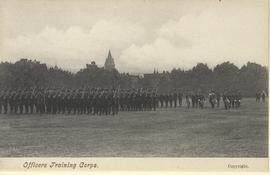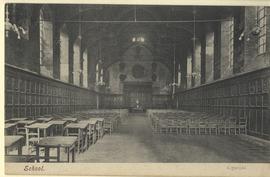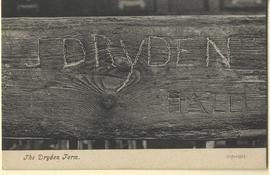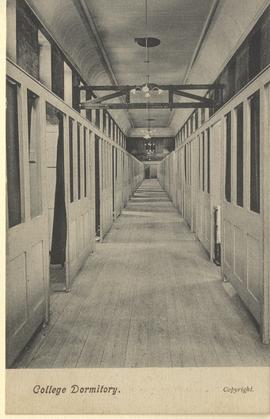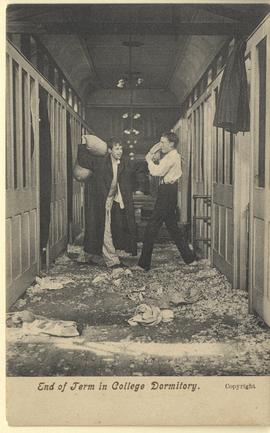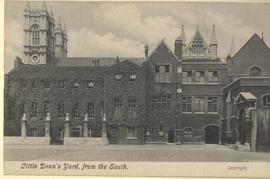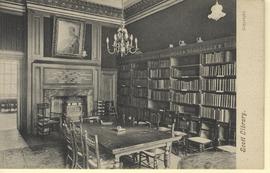One copy annotated on reverse by R.S. Chalk, as follows:
'Memories 1918-1924
This is presumably Inspection up Fields in days before World War I. Such an annual Inspection, even after that War was an impressive affair- conducted by this or that distinguished O.W. soldier. The Band (I remember) played Handle’s March from ‘Scipio’, on each occasion.
By the end of the War, the Q.T.C. (invariably referred to as “The Corps”) was all-important in School life. I suppose 80% of boys were in uniform all days of the week - the majority of the remainder waiting till their uniforms arrived. Few senior boys had School uniform, and the sudden announcement in Lent 1919 (after the Armistice) that all must wear Etons or tails from next Term caused panic.
Unless exempted on medical grounds, it was quite exceptional for anyone not to be in the Corps. Nor without reason - all were due to be called up at 18. It was not unusual for a boy to leave School then be at the Front by the end of that year - in some cases, not to return.
The School’s War Record was a very fine one, not least as the result of high standards in the Corps - 220 names on the War Memorial, I believe - and each trained as an Officer before leaving School.
Numbers in the Corps declined in years after the War, but high standards continued. K.SS in particular took Corps very seriously.'
One copy annotated on reverse as follows, by R.S. Chalk:
'Memories 1918-24 R.S.C
School- one of the three great losses in the Blitz.
Vastly impressive, tho’ by comparison with its present day counterpart, sombre, dusty and dark. (Yet HCW once lamented the Victorian ‘vandalism’ which enlarged all the medieval windows save one!)
Used for Assembly, lectures, Orations, Concerts, O.T.C. Parades (if wet), Physical Drill (‘Phys Hell’), Exams (as in this picture) and, above all, Latin Prayers.
Latin Prayers each day were a real joy- I never once heard criticism. All joined in singing in Elizabethan Latin. (I remember once (about 1920) three Arab Sheikhs attended these Prayers, and much impressed). The Masters knelt in the middle gangway on ‘pancake’ kneelers thrown (sic) out to them.
In the top foreground (then as now) may be seen the Pancake Bar. I was present in my second Term (Lent 1919) at the most famous Greaze of all- witnessed by King George V, Queen Mary, Prince of Wales and Prince Albert- won by D.L Moonan, K.S'
One copy annotated on reverse by R.S. Chalk, as follows:
'The ‘Dryden Form’ was kept unobtrusively somewhere behind the semicircle of seats for the Monitorial Council at the N. end of School. Few saw it there, and few cared.
It was first pointed out to my father and myself by E.L. Fox when I appeared for my first Challenge in 1918.
No doubt (likes so much else stored Up School) it perished for ever in the Blitz.
The Form itself was exceedingly rough, worn by the seats of generations.
In the dim light of School the letters could barely be made out (It may be noticed John Brown has traced them round in chalk for this photograph). To my mind it is open to question whether they were carved by the Poet or by his son of the same name (K.S. 1682-5). Nearby was cut in huge, deep letters ‘A.SLADE’. We all knew the tradition that it had cost him 500 lines for each letter (see L.E. Tanner, p32)'
One copy annotated on reverse by R.S. Chalk, as follows:
'This unpretentious Memorial faced us every time we came down School after Prayers. It aroused no interest, except for the unusual name ‘Prothero’. We were under the impression that the Latin inscription was composed by J.S. (Jn. Sergeaunt) – in fact it was (I believe) by Prof. J.S. Phillimore.
It is ironical that this Memorial should have survived the Blitz intact while so much around it (including the Great War Memorial) was completely destroyed. It was one of the few things I recognised when I re-visited the rains of School in 1945 after my long sojourn in India.
Only a few feet away (on the wall facing the VI Form Window) are the two cryptic names which I can claim the honour of deciphering- JOSEPH PRESTON, in Hebrew (which I took as a VII Form Option at School) and E.R. GLYN in Hindi Nagaric characters (which I learnt while in India).'
One copy annotated on reverse by R.S. Chalk, as follows:
'Memories 1920-1924
Dormitory- never abbreviated to ‘Dorm’ (as RR, GG)
My abiding impression is that it was 56 yards long (perhaps erroneous). I have often sprinted the length of it during fagging duties as a Junior. So did we all at 7:30 each morning, clad in two towels, as our daily course to or from ‘Way’ (Out and up by 7:45 or..!).
Dormitory was wonderfully spacious and airy, and well warmed in winter. But of course no view, as the windows were high up. (It has since the Blitz been rebuilt as two floors, while Wrens roost in what were then the six Election Rooms (including Prayer and Lumber Room) on the Ground Floor below. Sic transit Gloria!
If I recall alright, there were 21 Houses on the left (including the Captains, seen protruding at the end) and 19 on the right (divided by the alley-way from PiWi’s house).
The wooden beam half way along formed the back of the ‘Gods’ during Plays. At the end may be seen the Liberty Boy Tablets; ‘ELECTIO’ Doorway (see L.E.T.) is out of sight on right. After Lights Out, Dormitory was lighted by 3 bulbs only- arrears of Prep done by light of these!'
One copy annotated on reverse by R.S. Chalk, as follows:
'Memories, 1920-1924
After the cramped conditions prevailing in Rigaud’s Little Dorm, it was a joy to have a ‘House’ of my own, even as a Junior. It provided space, comfort and a welcome degree of privacy.
Pasted up in each House were “The Ten Rules of College”- the Magna Carta of Under Elections. I still remember: “Punishment to be by tanning or [for Upper Elections] desking, and in no other way”, and “No servants’ work to be done by any Under Election”. (There were of course two College Johns- and the ‘Nymphs’).
Each House was screened by a red-baize curtain. At ‘Lights Out’ (9:30) Mon. Chaun. and his partner pulled this back (rather farcically!) to make sure all Under Elections were in bed (of course his coming could be nicely timed!). The commonest occasion for a ‘Case’ was to be out of one’s House (even by an inch) after that.
In this picture, note (a) the hat-box, (b) school photos, no doubt purchased from John Brown.
It may also be noted that the ‘floreat’ (i.e. chamber-utensil) has been removed out of sight. This was called “Setting to Rights” and was regularly ordered on Play Nights, to avoid shocking curious guests who peered inside Houses!'
One copy annotated on reverse by R.S. Chalk, as follows:
'This picture would have been ‘posed’ by John Brown. As Under Election John he would have had to clear up the mess after Term, together with the long-suffering ‘Nymphs’ (as the two College charwomen were termed).
I do not recall any such (rather senseless) ragging at the end of any of my 12 Terms in College (in any case, at the end of Play Term Under Elections, depicted here, were accommodated up Saignes).
There was however one annual event on the last Saturday night of each Election Term, as an aftermath of the feast which followed Declams. This was Conveniences Race, a knock-out in which the Juniors competed in pairs, as a part of gaining their ‘freedom’. It consisted of a hurdle-race over towel-horses the length of Dormitory, out to Conveniences (Night Japs), to touch the door-handle there (a good bit of rough play took place here) and so back, cheered by occupants of one’s Room. Competitors wore pyjamas, and (an innovation I remember in 1924) top hats with white ties round the crowns.'
One copy annotated on reverse by R.S. Chalk, as follows:
'1918-1924 Ashburnham House & (formerly) Turle’s House
Easily the most attractive aspect of Yard. (Note abundant Virginia Creeper. A pity those ball-topped pillars were removed not long after my time.)
From left to right:
(Ground Floor) A.HH (the largest of the five Houses) with 90+ Day boys): Suts (by door); Notice-boards/ Orderly Room (?): entrance to Dark Cloister, Armoury & Gym.
(First Floor) Lib: Classical Under & Upper Shell Form Rooms (the latter nearest School)
(Top Floor-originally Servants’ quarters) Various Class-rooms, including IV, and (nearest School) Music Room.
(These were not all originally built for the purpose and would be considered totally unsuitable in any Comprehensive School today!)
Yard was laid half with yellow gravel, half with flag-stones; on the latter K.SS still played the obsolescent game of ‘Woodens’, tho’ rather half-heartedly.'
One copy annotated on reverse by R.S. Chalk, as follows:
'‘Lib’ was my far the most usual ‘occupat’ for boarders between School and prep. For one thing, most of us (I for one) were too jolly tired after the long day’s work to indulge in any more strenuous activity. That blissful hour of quiet from 5:15 till House bells rang for Tea at 6.10 remains a happy memory. Peace for a while!
Under the austere Librarian Rev. G.H. Nall and his elephantine assistant J.J. Huckwell, the rule of SILENCE was most rigidly observed. Some relaxations were introduced from 1922 under A.T. Willett, when board games such as Chess or even ‘Attack’ were provided.
On wet days, Lib was occasionally a welcome alternative to Station up fields.
We were proud of Lib, and used to boast it contained 10,000 books (!). Of these the most popular were “Dracula” (I never obtained it till my sixth year) and, among humorous works, Stephen Leacock.
The walls of Lib were covered by prints of noted OWW. I was sad (if not surprised) to find these replaced after the War by contemporary art'
1 copy annotated on reverse by R.S. Chalk, as follows:
'Memories, 1921-1924 R.S.C
The School Coin Collection was formed in the main by Dr Scott, who presented it to the School in 1874 (see first Number of ‘Elizabethan’). The bulk of the coins were kept in trays in a handy-size cabinet in the H.M.’s house. At some date unknown the most spectacular and interesting specimens were extracted & placed in a glass cabinet in the ‘Coin Room’ up Lib (as shown). They were expertly mounted and labelled by the British Museum, but attracted no interest at all, being badly lighted, under glass and tarnished black.
Tho’ but an amateur, I was given the charge of the School Coin Collection by H.C.W. in Play 1921. I do not think they had been touched since Dr. Scott’s day. The task of cleaning, re-arranging and cataloguing these coins (I seem to remember there were just over 900- Greek, Roman Republican & Imperial, Saxon and English) occupied me till 1929, when H.C.W. kindly staged a small Numismatic Dinner in recognition of this.
It was not till years later I learnt what a superlative collection I had been handling and what a precious possession the School had. (Now “dispersed”?!!**)
I urged H.C.W. that the Cabinet up Lib be dispensed with and the coins in it amalgamated with the main Collection. He understood, but could not agree to this. Result - the Cabinet disappeared without trace during the Evacuation, including ‘OFFA REX’ now catalogued £800.'
